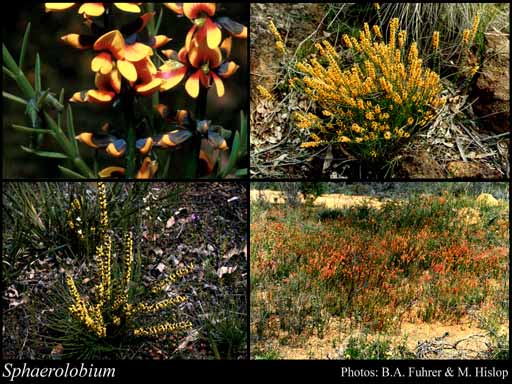- Reference
- Ann.Bot. 1:509 (1805)
- Name Status
- Current

Scientific Description
Family Papilionaceae. Mirbelieae.
Sometimes included in Leguminosae.
Habit and leaf form. Shrubs (or undershrubs). Fairly ‘normal’ plants, or switch-plants (often with rushlike branches); with the principal photosynthesizing function transferred to stems. Leaves well developed (but small), or much reduced (and rarely persistent, save for the scalelike bases), or absent (often ostensibly). Plants unarmed. Leaves cauline. Plants with neither basal nor terminal concentrations of leaves. Xerophytic. Cladodes semiterete, or terete, or solid/angular; unarmed. Leaves minute to medium-sized (2–10(–26 mm); alternate, or opposite, or whorled; non-sheathing; simple. Leaf blades entire; linear, or subulate. Leaves usually without stipules.
Reproductive type, pollination. Fertile flowers hermaphrodite. Unisexual flowers absent. Plants hermaphrodite. Entomophilous.
Inflorescence and flower features. Flowers solitary (rarely?), or aggregated in ‘inflorescences’ (or in groups in the axils); not crowded at the stem bases; in racemes, or in fascicles. Inflorescences simple, or compound. The terminal inflorescence unit racemose. Inflorescences terminal, or axillary; of terminal or lateral racemes, the flowers either solitary or 2–3 at each bract. Flowers pedicellate; bracteate (leaflike). Bracts persistent, or deciduous (then leaving their scalelike bases). Flowers (bi-) bracteolate (at the base of the calyx). Bracteoles persistent (rarely), or deciduous. Flowers very irregular; zygomorphic. The floral asymmetry involving the perianth to involving the androecium. Flowers papilionaceous; tetracyclic. Floral receptacle developing a gynophore. Free hypanthium present, or absent. Hypogynous disk present; intrastaminal; annular. Perianth with distinct calyx and corolla; 10; 2 -whorled; isomerous. Calyx present; 5; 1 -whorled; gamosepalous; 4–5 lobed; imbricate; exceeded by the corolla; bilabiate (the posterior pair of members connate, forming a large, truncate or emarginate upper lip, the anterior three smaller and freer); non-fleshy; persistent; non-accrescent; with the median member anterior. Corolla present; 5; 1 -whorled; appendiculate, or not appendiculate. Standard not appendaged. Corolla partially gamopetalous. 2 of the petals joined. The joined petals anterior (forming the keel). The wings of the corolla free from the keel; not laterally spurred. Standard ‘normally’ developed; slightly emarginate. Keel straight or incurved, conspicuously exceeded by the wings, or about equalling the wings, or conspicuously exceeding the wings (and the keel shorter or longer than the standard); not long-acuminate/beaked; neither coiled nor spiralled; not bent and beaked. Corolla imbricate; yellow, or yellow to orange, or yellow to orange, or yellow, orange, and red (the standard sometimes with a red spot); deciduous; non-accrescent. Petals shortly clawed. Androecial members definite in number. Androecium 10. Androecial sequence determinable, or not determinable. Androecial members free of the perianth; all equal to markedly unequal; free of one another; 1 -whorled. Androecium exclusively of fertile stamens. Stamens 10; all more or less similar in shape; diplostemonous; both opposite and alternating with the corolla members; filantherous. Anthers separate from one another to connivent; all alike; dehiscing via longitudinal slits; latrorse, or introrse; tetrasporangiate. Gynoecium 1 carpelled. The pistil 1 celled. Carpels reduced in number relative to the perianth. Gynoecium monomerous; of one carpel; superior. Carpel stylate. Style greatly (in-) curved. Style flattened. Style usually with a membranous wing, or fringe of hairs, below the stigma. Carpel 2 ovuled. Placentation marginal. Ovary stipitate. Ovules shortly funicled; biseriate; non-arillate.
Fruit and seed features. Fruit stipitate; non-fleshy. The fruiting carpel dehiscent; a legume. Pods globose (or even shorter than long, often oblique); not triangular; becoming inflated (usually?), or not becoming inflated; somewhat compressed, or terete; not constricted between the seeds; not transversely septate; wingless. Fruit 1 celled. Dispersal unit the seed. Fruit 1–2 seeded. Seeds not mucous; non-arillate. Embryo bent (the radicle inflexed). Testa non-operculate.
Geography, cytology, number of species. Native of Australia. 2n = 18. A genus of 14 species; 18 species in Western Australia.